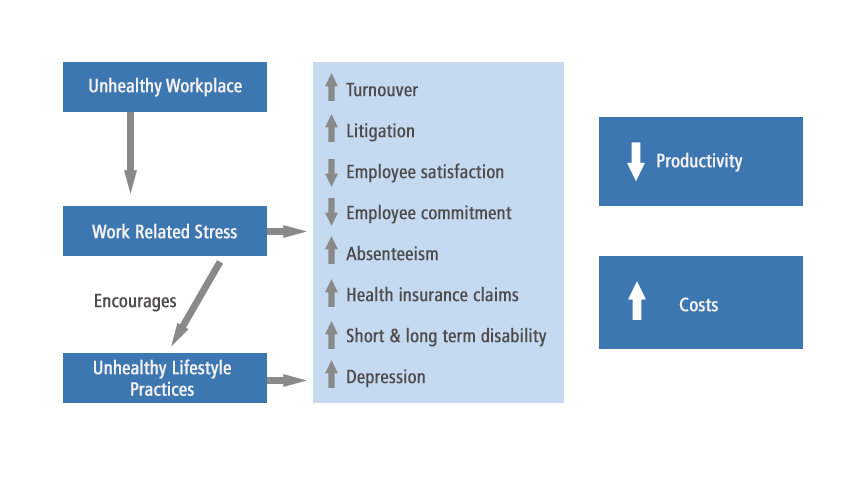The Financial burdenBurden of Job StressFinancial Burden
About one-third of workers report high levels of stress. This can create a burden for employers in health care costs, periods of disability, absenteeism, job turnover and poor productivity.
How costlyCostly is Job Stress? How costly is job stress?
Job stress is estimated to cost American companies more than $300 billion a year in health costs, absenteeism and poor performance. In addition, consider these statistics:
- 40% of job turnover is due to stress. [1]
- Healthcare expenditures are nearly 50% greater for workers who report high levels of stress. [2]
- Job stress is the source of more health complaints than financial or family problems. [2]
- Replacing an average employee costs 120-200% of the salary of the position affected. [3]
- The average cost of absenteeism in a large company is more than $3.6 million/year. [4]
- Depression is the largest single predictor of absenteeism and work related performance. [5]
- Depressive illness, a common side effect of job stress, in employees is associated with nearly 10 annual sick days (this study included one large firm). [6]
- For every 47 cents spent on treating depression, another 53 cents is indirectly spent on absenteeism, presenteeism, and disability. [7]
- Insurance data indicates insurance claims for stress related industrial accidents cost nearly twice as much as non stress related industrial accidents. [8]
The Cost of Doing Nothing nothing

Graphic adapted from "The Business Case for a Healthy Workplace" produced by Industrial Accident and Prevention Association. To download the full report, click here.
References
[1] Hoel, H., Sparks, K., & Cooper, C. (2001). The cost of Violence/Stress at work and the benefits of a violence/stress-free working environment. International Labour Organisation.
[2] National Institute for Occupational Safety and Health (NIOSH). Stress At Work Booklet. Publication No. 99-101.
[3] Flash, What is the cost of employee turnover? Compensation & Benefits Review, Sept/Oct 1997: Article #8582, 1998.
[4] NIOSH. Costs of absenteeism, cited 2002, available from http://hr.cch.com/default.asp
[5] Munce, S. E., Stansfeld, S.A., Blackmore, E.R., & Stewart, D. E. (2007). The role of depression and chronic pain conditions in absenteeism: Results from a national epidemiologic survey. Journal of Occupational Environmental Medicine, 49(11), 1206-1211. (PubMed)
[6] Druss, B. G., Rosenheck, R. A., & Sledge, W. H. (2000) Health and disability costs of depressive illness in a major U.S. corporation. American Journal of Psychiatry, 157(8), 1274-1278. (PubMed)
[7] Johnston, K., Westerfield, W., Momin, S., Phillippi, R., & Naidoo, A. (2009). The direct and indirect costs of employee depression, anxiety, and emotional disorders: An employer case study. Journal of Occupational Environmental Medicine, 51(5), 564-577. (PubMed)
[8] Perkins, A. (1994) Saving money by reducing stress. Harvard Business Review, 72(6), 12.
